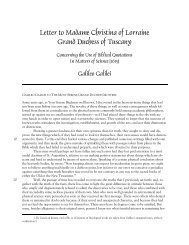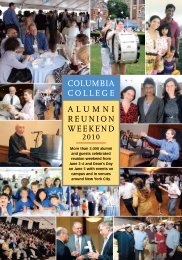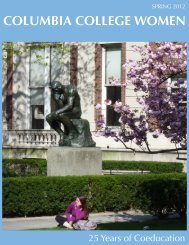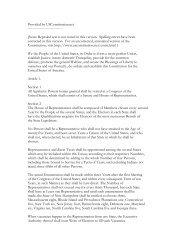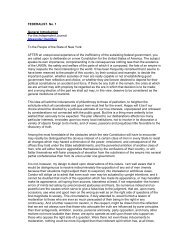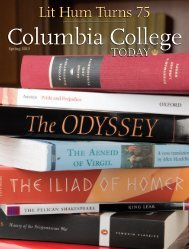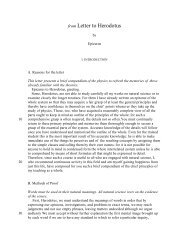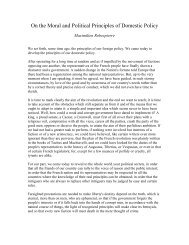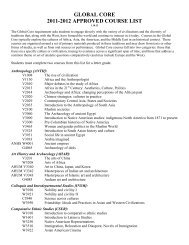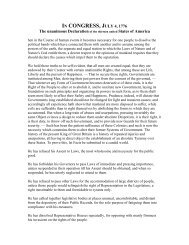A Passion for Science - Columbia College - Columbia University
A Passion for Science - Columbia College - Columbia University
A Passion for Science - Columbia College - Columbia University
Create successful ePaper yourself
Turn your PDF publications into a flip-book with our unique Google optimized e-Paper software.
CLASS NOTES <strong>Columbia</strong> CollEgE Today<br />
Melvin i. urofsky ’61 Sets the Bar <strong>for</strong> Studying Brandeis<br />
For Melvin I. urofsky ’61,<br />
’68 GSAS, Louis D. Brandeis<br />
is like the man who<br />
came to dinner — and<br />
never left.<br />
Urofsky, a historian, has devoted<br />
decades to the legal lion<br />
of Louisville who ascended to<br />
the U.S. Supreme Court under<br />
Woodrow Wilson and, after<br />
serving on the high bench <strong>for</strong><br />
23 years, left an enduring mark<br />
on jurisprudence and political<br />
thought.<br />
The culmination of a lifetime<br />
of scholarship was Urofsky’s definitive<br />
biography, published by<br />
Pantheon Books in 2009 to critical<br />
acclaim. Louis D. Brandeis: A<br />
Life, a doorstopper at 953 pages,<br />
came on the heels of seven<br />
volumes of Brandeis correspondence<br />
that Urofsky collected,<br />
co-edited and published with<br />
David Levy, a history professor at<br />
the <strong>University</strong> of Oklahoma.<br />
How long did it take Urofsky<br />
to write the Brandeis biography?<br />
“It took 45 years,” he says,<br />
laughing.<br />
To serious students of the<br />
Supreme Court, Urofsky’s work<br />
is no joke.<br />
“Mel Urofsky is the gold<br />
standard <strong>for</strong> Brandeis scholars,”<br />
says Jeffrey Rosen, legal affairs<br />
editor of The New Republic and<br />
a law professor at The George<br />
Washington <strong>University</strong>. Urofsky,<br />
he adds, “has written a Brandeis<br />
biography <strong>for</strong> our time.”<br />
David Pride, executive direc-<br />
tor of The Supreme Court Hist-<br />
orical Society, which awarded<br />
Urofsky its Distinguished Gris-<br />
wold Prize <strong>for</strong> the biography in<br />
2010, calls Urofsky “the <strong>for</strong>emost<br />
Brandeis scholar in the<br />
country.”<br />
All told, the Urofsky oeuvre<br />
encompasses 52 books he either<br />
wrote or edited. His American<br />
Zionism from Herzl to the Holo-<br />
caust, published in 1975, won<br />
the Jewish Book Council’s Morris<br />
J. Kaplun Award in 1976, and<br />
his Brandeis biography won the<br />
<strong>University</strong> of Louisville Louis D.<br />
Brandeis School of Law’s 2010<br />
Brandeis Medal. Urofsky appears<br />
in a 2007 documentary, Justice<br />
Louis D. Brandeis: The People’s<br />
Attorney, produced to mark the<br />
sesquicentennial of the justice’s<br />
birth, and he has lectured at<br />
venues around the world <strong>for</strong> the<br />
State Department.<br />
Not bad <strong>for</strong> a kid from Liberty,<br />
N.Y., a small town in the Catskills<br />
where, Urofsky remembers, he<br />
Melvin I. urofsky ’61 says his definitive biography of <strong>for</strong>mer Supreme<br />
Court Justice Louis D. Brandeis is the product of 45 years of work.<br />
PhOTO: JEFF wATTS, COuRTESY OF AMERICAN uNIVERSITY<br />
B y eu G e n e L. me y e r ’64<br />
MAY/JUNE 2011<br />
54<br />
literally knew everyone he encountered<br />
on a stroll down Main<br />
Street.<br />
His family roots, however,<br />
were on the Lower East Side.<br />
Urofsky’s grandfather, a barber,<br />
“summered” in the Catskills,<br />
cutting the hair of resort-goers,<br />
then moved the family to Liberty<br />
and opened his own shop.<br />
Urofsky’s father was a bookkeeper,<br />
killed in a WWII training<br />
incident in Texas; his mother<br />
was a telephone operator.<br />
Urofsky was valedictorian of<br />
his high school class of 75, in<br />
a school that had 12 grades in<br />
one building.<br />
A local <strong>Columbia</strong> alumnus, Dr.<br />
Harry Golembe ’17, ’19 P&S, encouraged<br />
him to apply, and a full<br />
tuition scholarship sealed the<br />
deal. He lived in Livingston (now<br />
Wallach) Hall, entering as an<br />
engineering student but switching<br />
to history after higher level<br />
calculus and chemistry courses<br />
confounded him. Peter B. Kenen<br />
’54, the great economist, was<br />
Urofsky’s adviser, and Bernard<br />
W. Wishey ’48, ’58 GSAS, Henry<br />
Steele Commager and Walter P.<br />
Metzger ’46 GSAS were among<br />
his teachers. “This was a history<br />
department of stars in those<br />
years,” Urofsky recalls.<br />
It was in Metzger’s 20thcentury<br />
American history class<br />
that “a light bulb went off — I<br />
could do that,” Urofsky says. So<br />
he went to GSAS, with the notion<br />
that he, too, could teach.<br />
He earned a Ph.D. in 1968 in<br />
history.<br />
Urofsky “fell in love” with an<br />
American history course covering<br />
1877–1920 that was taught<br />
by William Leuchtenburg. This<br />
led to a doctoral thesis proposal<br />
on Brandeis’ role in shaping<br />
Wilson’s progressive plat<strong>for</strong>m<br />
<strong>for</strong> a “New Freedom.” But after<br />
spending “a very happy day” immersed<br />
in the Brandeis papers<br />
in Louisville, Urofsky concluded<br />
the documents did not justify a<br />
thesis, which then became his<br />
1969 book, Big Steel and the<br />
Wilson Administration: A Study<br />
in Business-Government Re-<br />
lations.<br />
By then, Urofsky was an<br />
instructor at The Ohio State<br />
<strong>University</strong>, where he began a<br />
collaboration with a colleague,<br />
Levy, that resulted in the eventual<br />
publication of seven volumes<br />
of Brandeis letters. “We<br />
got a National Endowment <strong>for</strong><br />
the Humanities grant in 1967<br />
[followed by several renewals],<br />
went to Louisville together and<br />
Xeroxed papers,” Levy says.<br />
“We brought the papers back<br />
to Columbus and laid them out<br />
on the floor of his house. We<br />
both had the feeling his wife<br />
was chagrined.”<br />
They were right. “Louis and<br />
the papers were very often<br />
under my feet,” says Susan<br />
Urofsky. “They were sorting the<br />
letters into multiple volumes.<br />
There were just mountains of<br />
paper around.”<br />
Five books of edited and<br />
annotated letters were completed<br />
by 1978 and two more<br />
were published in the 1990s,<br />
after the two Brandeis scholars<br />
obtained access to the papers<br />
of Supreme Court Justice Felix<br />
Frankfurter and the letters<br />
Brandeis wrote to his family.<br />
Meanwhile, Urofsky had<br />
carved out a career at Virginia<br />
Commonwealth <strong>University</strong>, in<br />
Richmond, where he chaired<br />
the history department from<br />
1974–81. His Brandeis work




